
Gabrielle “Coco” Chanel, 1920“Luck is a way of being. Luck is not a little person. Luck is my soul.” — Gabrielle Chanel

Gabrielle Chanel was born in 1883 to a laundrywoman and an itinerant street vendor who peddled work clothes and undergarments. He lived a nomadic life. The family resided in rundown lodgings. When her mother died when Gabriele was 11, she was sent to an orphanage at the convent of Aubazine. It was a stark, frugal, life and her six years there taught her how to sew.
By the time she arrived in Paris in 1907 and before she was known as “Mademoiselle,” Gabrielle Chanel was already noted for her ensembles of a black smock, white lavalliere with a velvet bow, and orphan shoes. She hated aigrettes, flounces, trains, lace, pastel chiffons and silks. “I want to give women their freedom back and without corsets, underwear, and padding.”
She wore clothes she created that she had borrowed from men’s tailoring. Jersey sailor tops for ease of movement, sports suits that would not hamper her movements, and she embraced the style with the determination of a pioneer. She wanted to be part of the future. Chanel was inspired by the men in her life and by the places she liked to frequent, such as beaches, sporting venues, and racetracks.
She moved in with horse breeder Etienne Balsan at his apartment 160 boulevard Malesherbes in Paris. That location became her first millinery workshop. Later she fell in love with Arthur Boy Chapel, an extremely rich English businessman, the epitome of British elegance. She wore his suits and he admired her spirit, her vitality, her slim silhouette. She never wed, but had many lovers, including the Duke of Westminster, the poet Pierre Reverdy, the Baron von Dincklage, Jacques Chazot, and designer Paul Iribe.
Now she began to seduce Paris.
She visited only the most select places such as Maxim’s and Laperouse and the private salons. She lived exclusively in the fashionable districts. Society ladies and actresses were at her feet. She would leave Paris to go on holiday to resorts with sea air and dazzling sunshine. In Deauville in 1913, she opened up her first boutique and honed her philosophy of suitable clothes for every occasion, place, and circumstances.
Few creations have had a greater influence on fashion than the Chanel suit. A classic symbol of French elegance, the suit is constructed according to a precise code: Strict lines, a fitted cut articulated at exactly the right places to allow ease of movement, braid trimming on the jacket, and real pockets. Braids and trimmings underline the contours of the jacket, redefine it, edge the pockets, and cuffs always with impeccable style. For “Coco” Chanel, luxury lay in invisible perfection.
She created the Chanel brand by virtue of her prolific fashion sense and included couture clothing, jewelry, handbags, and fragrance. Her signature scent Chanel No. 5 has become an iconic product. She is the only fashion designer listed on Time magazine’s list of the 100 most influential people of the 20th Century. Chanel designed her famed interlocked CC monogram which has been in use since the 1920s.
“Coco” Chanel died January 10, 1971 at age 87 in Paris. She rests at the Bois-de-Vaux Cemetery in Lausanne, Switzerland. Just as she had said, “To be irreplaceable, one must be different.”

